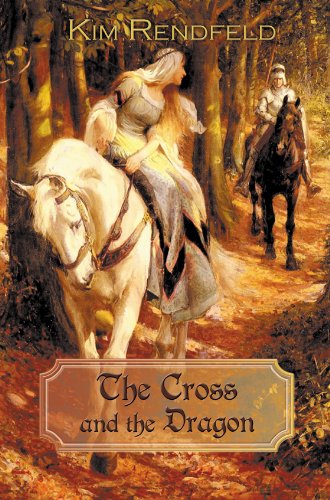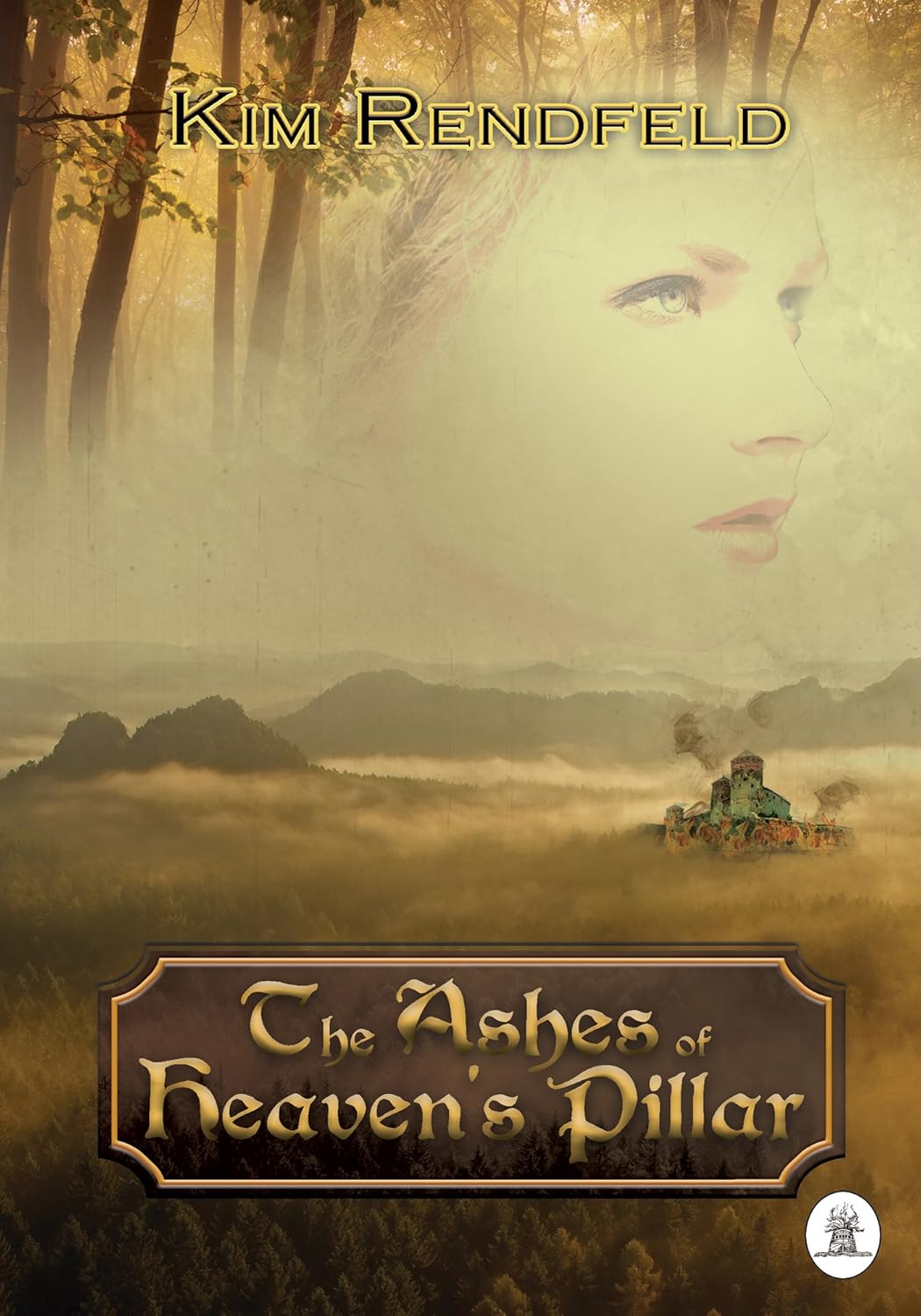I am pleased to welcome a fellow Fireship crew member, Kim Rendfeld, the author of a Carolingian series. She has already completed two novels in the series, The Cross and the Dragon and The Ashes of Heaven's Pillar. I understand, there is a third novel in progress.
MJN: Your books are intended to work as a loosely linked
trilogy. The Cross and the Dragon, which was published first, is
actually the second novel in the series. Hruodland, the focal character
in The Cross and the Dragon, makes a brief cameo appearance in Ashes
of Heaven's Pillar. The Cross depicts the world of the ruling
class, while Ashes depicts the world of peasants. I think it's
wonderful that you have the same era shown through the eyes of people of
different classes. Do you find it more liberating than writing a strict
trilogy where you need to read book 1 to know what's going on in book 3?
KR: If what I’m writing is a trilogy or a series, it is
in the loosest sense of the word. And it’s by accident.
I
wrote Cross and Dragon first and intended for it to be a stand-alone
book about two medieval lovers separated by war. But when I finished, I went
through a form of grief that I could assuage only by writing another book.
At
first, I was going to write about the continuing adventures of two nuns I’d met
in Cross and Dragon, but I just couldn’t get a plot together. Then, the
backstory of a Saxon family sold into slavery captivated my interest, and
that’s how Ashes was born.
Readers
might feel liberated because they don’t have to commit to multiple books to see
the storyline all the way through. These novel are separate stories, with their
own plots, heroines, and villains. When I’m asked which book should be read
first, I reply whichever appeals to you more. But if you read Cross and
Dragon first, you’ll understand a minor back story in Ashes a little
better.
I
am working on a third book, which starts four years after the last two end.
Charlemagne, called King Charles in my novels, makes cameos in both Cross
and Dragon and Ashes. In Lady Queen Fastrada (my working
title), he plays a strong supporting role as the husband of the title
character.
MJN: As a self-proclaimed "feminist with an attitude", it's understandable that you are fascinated by the lot of women in 8th century Europe. I applaud you for not injecting 21st century ideas into the heads of 8th century heroines. I've read too many novels set prior to the rise of feminism where female characters toss their hair and say, "I am NOT a piece of property. Don't treat me like a piece of meat!" Something along those lines. I applaud you for not having Alda or Leova talk like Carrie Bradshaw from Sex & the City. How do you manage to keep the 21st century voice at bay?
MJN: As a self-proclaimed "feminist with an attitude", it's understandable that you are fascinated by the lot of women in 8th century Europe. I applaud you for not injecting 21st century ideas into the heads of 8th century heroines. I've read too many novels set prior to the rise of feminism where female characters toss their hair and say, "I am NOT a piece of property. Don't treat me like a piece of meat!" Something along those lines. I applaud you for not having Alda or Leova talk like Carrie Bradshaw from Sex & the City. How do you manage to keep the 21st century voice at bay?
KR: Part of keeping the 21st century voice at bay is my
desire to keep the readers in the dream. A modern concept in a medieval
mind is just as jarring as a knight riding a motorcycle. When I sit down at my
computer, I try to see events and surroundings as they would see them. While we
see 13-year-old girls in arranged marriages as pawns, medieval parents would
see their daughters as important partners in political alliances. If things well
(keyword is “if”), these young brides would grow into women with a substantial
influence over their husbands and sons.
One
real-life example: Charlemagne’s widowed mother, Bertrada, played the role of
diplomat, going all the way to Rome to keep the peace between her two sons,
ages 17 and 20, and prevent them from destroying what she and her husband had
built. So, real medieval women were not damsels in distress awaiting a rescuer.
They sought to shape the events around them, sometimes going to great lengths
to do so.
The
21st century voice is not completely silent. I’ve drawn on my own experiences
with grief to describe my heroines’ emotions when they lose someone close. When
I wrote about the Continental Saxons’ reaction to losing their sacred pillar,
the Irminsul, I was thinking of 9/11 and how that broke our hearts. Love,
grief, anger, and joy transcend every era.
MJN: I am also a feminist with an attitude (and a foaming-at-the-mouth careerist), and I am guilty of infusing too much of my personal belief into my story lines. For instance, I never have the leading female character being "just a mother and wife". All of my female characters have some sort of occupation that brings them at least a nominal income and provides some independence from the men in their lives. That's just my personal hang-up. I was raised by emasculating Amazons with PhDs, so naturally, I embrace that marginal value system. So when I research any era, I always want to know what professional options, however limited, were available to women. What were some of the opportunities for women to make money? What trades could they study and what goods could they manufacture?
KR: The early medieval economy was very different from
ours. People didn’t just go get a job. Commoners grew a lot of their own food
on their land, prayed for a decent harvest, and got some food from the forest.
They bartered with neighbors or sold excess produce or handicrafts at a market.
Travelers
were a good source of income because they would need food and supplies.
There
were a few honorable professions distinctively feminine such as laundresses,
weavers, wet nurses, nurse maids, and midwives. The women delivering babies had
a special status. They were the only laypeople with the authority to baptize.
While
aristocratic women were privileged, they had duties beyond motherhood. The
queen was responsible for her husband’s treasury and the many servants and
guards in the household. If the houseguests were foreign emissaries, it was
important they be impressed with the hospitality and wealth of their host, a
sign of power to report to their own rulers.
The
most independent aristocratic woman was an abbess. She would manage people and
land and influence politics, and there would be no man telling her what to do.
MJN: I am still trying to understand how 8th century Franks and Saxons regarded children. Were children viewed as a burden or as an asset? In 21st century America, a responsible parent can expect to invest into the child until that said child is in his/her mid-20s, given the cost of healthcare and higher education. I imagine, during Charlemagne's time, life expectancy was shorter, and children were expected to become useful to their parents at a much earlier age. What were some of the things people could expect from their children at any given age?
KR: The idea of childhood as a special time in life is
a relatively modern concept. Early medieval children, of all classes, were
expected to contribute to their families but in different ways. Peasants’
children worked as soon as they were able, even the 3-year-old scattering seed
to feed the chickens.
For
aristocrats, a pregnancy could mean a longed-for heir and political stability.
So they invested in their children to serve the long-term interests. They hired
wet nurses to hasten the time mothers would get pregnant again. The children’s
mother might teach them a couple of Psalms. Boys learned to fight, while girls
learned to weave and sew. A count’s son has a future of leading soldiers into
battle and settling disputes among the peasants he ruled. The duty of the
count’s daughter was to make a politically advantageous marriage. Either sons
or daughters could serve the Church, and even they held influential positions
and were expected to act on behalf of their families.
Unfortunately,
not all children were wanted, and it becomes painfully obvious in cases of
extreme poverty. A bad harvest meant everyone went hungry. Couples sometimes
sought contraception, despite Church teachings against it. Desperate women
might take dangerous herbs to induce abortion, and some parents murdered their
newborns. The Church differentiated between the reasons behind the deaths. The
penance for killing a child due to poverty was more lenient than a death to
cover up a sin.
Frankish
families were small, but many causes were beyond any human control.
Malnutrition and chronic illnesses like anemia and tuberculosis impaired
fertility. Another grim reality in an era before vaccines is that half the
children died before reaching age 5. That fact has led to a misconception that
medieval parents did not get attached to their babies. You need only read an
excerpt of the epitaph for Charlemagne’s 40-day-old daughter Hildegard to know
that’s not true: “Dear little maiden, you leave no little grief/Stabbing your
father's heart with a dagger.”
So
the attitudes toward children are as varied and complex then as they are today.
Whether kids were an asset or burden depends on the families and their
circumstances.
MJN: In Ashes of Heaven's Pillar, you have the female
protagonist and her children sold into slavery. You use the word slavery
versus serfdom. Can you explain the difference between the two concepts?
KR: I use “slaves” to describe Leova and her children
for a couple of reasons. They are war captives, and they become servants in
wealthy households. They, and their native-born peers, are tied to their owners
and could be bought and sold like livestock.
Serfs
were unfree native-born villagers who worked the lord’s land. A rarity in this
era, they were the lowest class but lived in the community. Serfdom would
become more common in the 10th and 11th centuries.
Most
peasants in the 8th century were free and owned some land to support their
families. That freedom came with obligations, like paying tribute to their
lords and having one man in their house serve in the army when it went to war.
What
makes this even more complicated is that sometimes slaves in a noble house were
better off than their free peasant counterparts. If you were part of an
aristocrat’s household, you were more likely to eat.



Zounds! What a great, interesting and informative interview. Thoroughly enjoyed it.
ReplyDelete